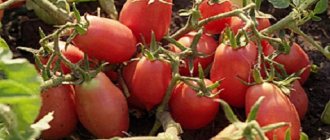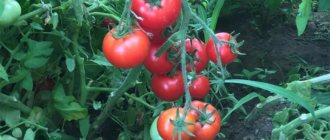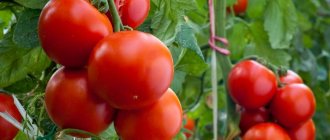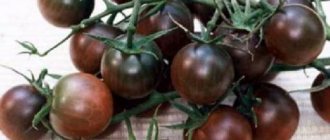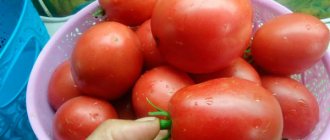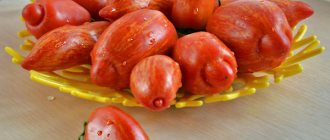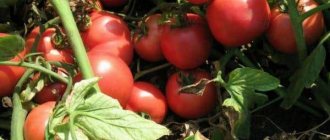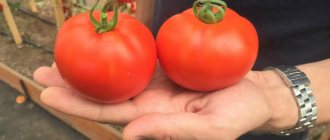It’s hard to even imagine that once upon a time in Russia, tomatoes were considered poisonous for a long time and were bred for decorative purposes. Today it is the most common vegetable in the world. Each gardener grows it on his own plot, looking for new, promising varieties. One of them is the Snow Leopard tomato.
Breeders developed this variety in 2007 and gave it a symbolic name, emphasizing that the crop can grow even in the harsh natural conditions where snow leopards are found.
Description
Snow Leopard tomatoes are low-growing (determinant) varieties. The height of the bushes is 50-60 cm (in shaded places they can stretch up to 70 cm). The leaves are large, dark green. It is considered to be an early-ripening tomato, but in more northern regions it is more likely to be mid-early.
Advantages of the variety:
- Easy to care for: does not require frequent fertilizing and watering, fertile soil, grows in sun and shade.
- Weakly reacts to adverse weather conditions and temperature changes.
- It is highly resistant to diseases that attack the leaves. True, it can become infected with late blight from diseased plants, but this happens closer to the end of fruiting.
- Tolerates transportation well.
- The yield, as for determinate varieties, is high - 2-4 kg per bush.
- Fruiting is consistent, occurs in several stages, and lasts until the beginning of autumn.
Tomatoes grow in clusters, 3-4 pieces each. There can be 2 brushes on one branch.
Fruit
The tomatoes are red-orange in color and have a round, slightly flattened shape. The skin is dense, smooth, but ribbed near the stalk. The average fruit weight is 120-150 g (there are record holders of 300 g). The taste is pronounced tomato, pleasant, with a slight sourness, fleshy, juicy pulp.
Use
Their main purpose is to be consumed raw to enrich the body with vitamins (after all, these are the first tomatoes). But at the same time, they are suitable for pickling and canning, culinary processing, making tomato paste and ketchup. They're convenient to pop in a jar, take to work or on the go, or put on the table as a snack.
Summarizing what has been said, we can conclude: Snow leopard is a high-yielding crop, resistant to fungal microorganisms and adapted to any climate, with good taste.
Main varietal characteristics
Before choosing a tomato variety that you are ready to plant on your plot, you need to find out reviews from gardeners, their recommendations, look at photos, and decide whether the yield of a particular tomato variety will satisfy you.
Today we recommend that you familiarize yourself with the Snow Leopard tomato:
- This tomato variety is an early ripening crop; the growing season until the first fruits appear lasts from 90 to 105 days.
- The Snow Leopard tomato variety is adapted for cultivation in greenhouses and open beds in any climatic regions of the Russian Federation.
- The plant is classified as a determinate species; the growth of the bush is unlimited, so staking and shaping of the plant is required. According to experienced vegetable growers who have already planted this variety of tomatoes, it is better to form the bushes into 1-2 stems, not allowing them to grow above 60 cm in height.
- The leaves of the Snow Leopard tomato are dark green in color and large. The number of leaves on the bush is above average; it is recommended to remove or pinch the lower and intermediate leaves so that they do not take away excess moisture, nutrients, and do not shade the entire plant.
- Tomato fruits have the shape of a flattened ball; there may be slightly pronounced ribbing on top. The density of the fruit is average, the skin is dense and strong, protecting the tomatoes from cracking. At the beginning of ripening, tomatoes are light green in color; ripe tomatoes have a beautiful red-orange color. The average weight of a tomato is from 120 to 150 g, but there are also record sizes of up to 300 grams.
- The yield for fruits of this size is significant, averaging 23 kg per square meter. m. per season.
- Snow Leopard tomatoes, according to the description of the variety by the creators themselves, are resistant to diseases such as fusarium - a fungal infection of the plant that causes wilting.
This is interesting! In South America, wild tomatoes are still found today; their fruit weighs no more than 1 gram. Maybe that's why the aborigines gave them the name tomatl - a large berry. In other countries, tomatoes were called apples: apples of paradise in Germany, apples of love in France.
Advantages and disadvantages
10 years have passed since the appearance of tomato seeds of this variety on sale. Many vegetable farms and amateur gardeners have been growing Snow Leopard tomatoes on their lands for many years. Based on their reviews, one can already judge the advantages and possible disadvantages of the variety.
The positive qualities of culture include:
- the ability to grow tomatoes both in greenhouses and in open ground, high adaptation to different climatic conditions;
- early ripening;
- resistance to fungal diseases;
- long-term preservation of presentation, transportability of the highest level;
- versatility in consumption: fresh, in pickled or salted preparations, in juices, ketchups and salads;
- excellent taste;
- high yield (if agrotechnical growing conditions are met);
- no need to remove stepchildren.
The downside to caring for tomatoes is that the bushes need to be shaped and tied to supports. Many gardeners do not notice this drawback; they accept it as doing a certain amount of work, which is always enough in the garden.
Landing
This crop is grown by seedlings and seeds, in open ground and under film. It is recommended to pre-treat the planting material with a growth stimulator.
The soil must be nutritious and moist. With the seedless method, they dig it up, apply complex mineral fertilizer or humus, and disinfect it. For seedlings, a nutrient substrate is prepared based on garden or turf soil, humus, river sand, vermiculite and wood ash (optional). Sowing is carried out at the end of February or at the beginning of March.
Seeds are sown in open ground when it warms up to 14°C. For central Russia, this is the end of April - the first half of May, but the plants grow quickly due to the fact that, unlike seedlings, they do not require time to take root. Before emergence, it is also recommended to cover them with film or glass.
Advantages and disadvantages of the variety
Snow Leopard tomatoes have spread widely among dacha farms. The main reason for its popularity is high yields and unpretentiousness. The bushes grow well in the climatic conditions of North-West Russia, the Urals and Siberia, even despite short-term drops in temperature.
Thanks to early ripening, Snow Leopard tomatoes have time to ripen on the bush
pros
- good taste;
- good keeping quality and transportability;
- the ability to grow in most regions of Russia;
- fruits do not crack during ripening and storage;
- universal use of tomatoes;
- low maintenance requirements;
- resistance to fungal infections.
Minuses
- the need to tie up the stems;
- Regular stepsoning is required.
Growing seedlings
Deepen the Snow Leopard tomato seeds into the soil mixture by 1 cm. Sprinkle peat on top and moisten with warm water. The containers are covered with glass to keep the soil moist and placed in a warm place. Shoots appear on the 3-5th day. Now they need a lot of light and an air temperature of no more than 20 °C. After 2-3 true leaves appear, the seedlings are planted in separate containers.
For better development, plants are fed with complex fertilizers and watered regularly. With the onset of warmth, the seedlings begin to harden, accustoming them to street air and sunlight.
Sowing seeds
In February - early March, gardeners begin to sow vegetable seeds for seedlings. Gardeners with extensive experience grow their plants this way only. Buying ready-made seedlings means taking a 50% risk, that is, getting the wrong variety of tomatoes, or already infected seedlings. This work needs to be done in several stages:
- Buy seeds from a responsible manufacturer or distributor, thus protecting yourself from mis-grading, and do not purchase seed from unscrupulous sellers.
- Prepare seeds for planting: select quality ones, soak them, wait for sprouts, sow the seeds in the prepared substrate. Ready-made mixtures can be bought in special stores.
- When three true leaves appear, pick the plants into separate containers. If necessary (the main root is very long), at this moment the roots are pinched, just a little, 0.5 cm.
- Then we wait for warm days favorable for planting seedlings in the ground. Until this time, we carry out regular watering; 2 weeks before transplanting into the soil, you can carry out the hardening procedure. Take the seedlings outside or onto the balcony every day, preferably into sunlight, for 2-3 hours.
How to properly prepare seeds
Beginning gardeners will find this section of the article interesting, so we will tell you in more detail how to prepare Snow Leopard tomato seeds for planting:
- you need to prepare a saline solution: for 200 ml of water - 1 heaped teaspoon of salt;
- pour tomato seeds into the solution and mix vigorously, leave for a while (about 30 minutes), remove the seeds that float to the surface, if any, carefully drain the water;
- Rinse the seeds remaining at the bottom from salt water and place on a napkin;
- to prevent fungal diseases, place tomato seeds in a weak solution of calcium permanganate for 20 minutes, you can simultaneously add 1 g of a growth enhancer, such powders or solutions are sold in stores;
- after time, drain the contents through a sieve, and place the prepared seeds on a soft, damp cloth, cover with the same cloth on top, place on a shallow dish, or maybe on a plate; if the cloth dries, moisten it with warm water;
- within 2-3 days, a maximum of a week, sprouts will emerge from the seeds, the time comes for sowing into the soil;
- You can buy ready-made earthen substrates, but if you have the opportunity, prepare it yourself; for this you will need to mix 2 parts of fertile soil, 1 part of sand, 1 part of peat or humus. All components must be disinfected by frying them in the oven on an old baking sheet. Processing time 1-2 hours.
- in a container with a substrate, make dimples 1-2 cm deep, you can use a regular pencil for this, the distance between the dimples is 4x4 cm, place 2 seeds in each hole (tomato seeds are very small, try doing this with tweezers);
- Cover the top with soil and only then water carefully so that the seeds do not clump together.
Cover the container with PVC film or a piece of glass, place it in a warm, shaded place, perhaps on the floor near a radiator. When two cotyledon leaves appear, the cover must be removed and the container placed closer to the light.
Care
Caring for the variety in question consists of the usual agrotechnical measures for tomatoes:
- weeding;
- feeding;
- watering (infrequent);
- pest control.
Although the bushes are low and compact, they still need to be shaped. Usually 1-2 stems are left. To prevent branches from breaking, they are tied or attached to a trellis. Pinching is not required, but due to the high foliage, it is better to tear off the intermediate and lower leaves.
The crop in question is a godsend for those who cannot devote much time to working in the garden.
Features of cultivation and storage
Fertilizers are applied to the planting area. Be sure to use compost, superphosphate, and saltpeter.
There are 4 bushes per 1 m2. Maintain a standard distance of 40-50 cm. The distance between furrows is 60 cm.
How to care:
- Irrigation with Bordeaux mixture at risk of fungal infection.
- Moderate watering at the root level at the rate of 6-8 liters.
- Carrying out regular fertilizing at least 2 times a month.
- Formation into 2-3 shoots.
- Fixation to a strong support.
What is used for fertilizer? The most effective way is to water the beds with a mullein solution diluted 1:10. Bio-infusions made from nettle and sedum are popular. Complex products are desirable during flowering and ripening.
Tomato Snow Leopard: description, photos, reviews
The Snow Leopard tomato is a relatively new variety that has quickly gained wide popularity among gardeners in the middle zone and colder regions of the country. The taste and quality of the fruit, high resistance to temperature changes, good yield and many other advantages have made this tomato a favorite of many gardeners.
Description of the tomato variety Snow Leopard
This tomato variety, bred in Russia in 2008, is considered mid-early. Snow Leopard tomato bushes are determinate; in open ground they do not grow higher than 60 cm.
When planted in a greenhouse and film shelters, this figure is slightly higher - 80-90 cm. The compactness of the bushes allows you to use more dense planting and save space on the site.
The tomato foliage is high, the foliage is large, dark green.
Description of fruits
Ripe tomatoes of the Snow Leopard variety are distinguished by their bright, richly colored skin, which has sufficient density to protect the fruit from cracking. The shape of the tomato is flattened, spherical, with slight ribbing at the top.
The average weight of one tomato is in the range of 120-150 g, but individual specimens weighing up to 300 g ripen. The bright red flesh has a rich taste with a subtle sourness. It contains an increased content of sugars and amino acids.
The pulp is juicy, fleshy, contains a small number of seeds.
The commercial characteristics of tomato are valued among gardeners who grow for sale: keeping quality and transportability are very high. The fruits do not lose their taste and attractive appearance for a long time.
Characteristics of the variety
A detailed description of the characteristics of Snow Leopard tomatoes gives a complete picture of this variety. The characteristics of the tomato are presented in the assessment of all important varietal indicators.
Productivity and fruiting
The productivity of the Snow Leopard variety is quite high, given the compactness and small size of the plants themselves. The yield indicator may vary when grown in a greenhouse and open ground.
In the latter case, it averages 2-3 kg/bush; in a greenhouse, 4-5 kg of sweet tomatoes are harvested from one bush.
Since 4 to 6 plants can be placed per 1 m2, the yield of the variety ranges from 8-30 kg/m2.
The yield of the variety is influenced by the quality of care for the bushes. And although these tomatoes are considered one of the most unpretentious, timely shaping, in special cases they need garter and watering.
Depending on planting conditions, Snow Leopard fruiting occurs 95-110 days after emergence. Tomatoes are formed on fruit clusters of 4-6 pieces.
Area of application of fruits
Grown tomatoes of the Snow Leopard variety will be an excellent ingredient in summer salads, as well as in winter preparations. Everything that cannot be eaten fresh can be processed - delicious juice, ketchup, pickles and marinades are obtained from these tomatoes.
Resistance to diseases and pests
The Snow Leopard variety is characterized by high resistance to many common tomato diseases caused by fungi. The risk of Fusarium or Verticillium wilt is low, which is good news for gardeners. The Snow Leopard also shows good resistance to crop pests.
Advantages and disadvantages of the variety
The relatively young tomato variety Snow Leopard quickly gained great popularity among Russian gardeners. The reason for this phenomenon is a whole range of advantages of the variety that gardeners liked so much:
- taste and commercial qualities of fruits;
- possibility of growing both in protected and open ground;
- high resistance to temperature changes and rapid adaptation to any conditions, which allow growing tomatoes in cold regions of the country;
- versatility of fruit use;
- resistance to diseases and pests;
- unpretentiousness in care, which allows summer residents who do not have the opportunity to be present in the garden every day to get a good harvest of tomatoes;
- absence of cracks on fruits during ripening, as well as during whole-fruit canning.
The only drawback of the Snow Leopard is the need to form bushes and garter the stems.
Growing rules
Growing Snow Leopard tomatoes has several features. They must be taken into account in order to get a high yield.
Planting seedlings
Sowing tomato seeds for seedlings begins in March and follows standard technology:
- Planting material is sown in pre-prepared loose and fertile soil, deepening it to 1-2 cm. Before planting, the substrate is moistened.
- Each container is covered with film to maintain humidity, put in a dark, warm place and wait for germination.
- As soon as the first shoots appear, the containers are placed on a well-lit windowsill.
- It is recommended to pick Snow Leopard sprouts at the stage of appearance of the first true leaves.
- Each sprout is carefully dug out from the total mass and transplanted into a separate container. If the seedlings have stretched out due to lack of sunlight, they are buried during transplantation. The thin stem does not rot in the soil, but develops adventitious roots.
- 10 days after picking, feed the seedlings with water-soluble complex mineral fertilizer.
- Care before planting in a permanent place comes down to moistening the soil, fertilizing and hardening.
You can learn more about sowing seeds for seedlings from the video:
Transfer
The timing of transplanting tomatoes to a permanent place falls on:
- early May for unheated greenhouses and greenhouses;
- the second half of April, if protective structures are heated;
- end of May when planting in open ground.
More precise timing for planting seedlings depends on the climate of the region and the recommendations of the Lunar calendar. By this time, the seedlings should have at least 6 leaves, a strong stem, the height of which is about 30 cm. The optimal age is 45-50 days.
There are several standard rules for transplanting tomatoes to a permanent location:
- In accordance with the planting scheme, small holes are dug in pre-prepared beds.
- Each seedling is placed in a hole at an angle of 450, sprinkled with soil and compacted.
- Watering is carried out, spending about 1 liter of water for each specimen.
Important! After watering, it is recommended to mulch the soil under the Snow Leopard bushes.
Since plants of this variety are very compact, choose a planting scheme that will save space on the site. Seedlings can be arranged in a strip-parallel pattern, maintaining a distance between adjacent seedlings of 25 cm and a width between rows of 60 cm. The most common planting option is a checkerboard pattern, in which all plants are well illuminated and care operations are simplified.
Aftercare
When growing a Snow Leopard tomato, they devote time to standard care operations: regular, but not excessive, watering, weeding, loosening the soil under the bushes. But obligatory operations are gartering and shaping the plants.
Since the yield of the variety is high, it is recommended to tie up the plants. This allows you to avoid breaking the stems under the weight of your own fruit. In greenhouse conditions, the tomato is tied to a trellis stretched at the top of the structure. In open ground, individual support stakes are usually organized, to which plant stems are tied.
The formation of bushes begins at the stage when they produce a strong stepson under the first flower cluster. It can be left to form a 2-stem tomato. This method is usually used when growing in a greenhouse or film shelter. In order to grow only 1 stem, all competing stepsons are promptly removed.
Important! To achieve good fruiting of the Snow Leopard, pinching is carried out regularly (the fattening shoots are removed when they reach a length of no more than 5 cm), and as the bushes grow, the lower leaves are removed.
Feeding bushes should be done with extreme caution. Snow leopards growing in well-fertilized soil tend to develop green mass.
Therefore, with intensive feeding, the bushes actively grow lush, beautiful greenery to the detriment of yield - very few fruits are formed on such plants.
Pest and disease control
Although the Snow Leopard is famous for its good resistance to pests and diseases, preventive measures will not hurt. These include:
- treating the soil before planting seedlings with a solution of potassium permanganate or fungicide;
- pre-sowing heating of seeds at a temperature of 500C;
- timely watering and its norms;
- removing weeds and plant debris from the tomato bed.
All these manipulations do not take much time, but they allow you to avoid possible problems associated with the activity of insect pests and pathogens of crop diseases.
Conclusion
The Snow Leopard tomato is easy to care for, easy to grow and has reliable yields even in the worst gardening seasons. Even a novice gardener can grow these tomatoes and reap a good harvest. The main thing is to take into account some of the features of planting and care, and if everything is done correctly, the bushes will be strewn with glossy, delicious tomatoes.
Reviews
Gardeners who grow certain varieties of tomatoes on their plots love to share their results, so they leave reviews on the Internet. They are also actively discussing Snow Leopard tomatoes.
Olenev Boris Olegovich, 60 years old, Chelyabinsk I love tomatoes grown in open ground; in my opinion, their taste is more pronounced than those grown in greenhouses. But in the Southern Urals it is difficult to choose a variety that will bear fruit normally - the summer is short, cold, the tomatoes have to be picked while still green and left to ripen at home in a box. Last season I grew Snow Leopard tomato seedlings, planted them, and the result exceeded all my expectations! I picked 2.5 kg of excellent tasting tomatoes from one bush. There was no damage such as cracks on any of them. Now I will always set aside a small bed for them and try new varieties. Marina Ivanovna Zakharenko, 36 years old, Kurgan I learned about this variety from the Internet. Before deciding to plant a Snow Leopard tomato, I read the reviews and characteristics (for me, yield is important, first of all), and looked at photos of tomatoes. In general, the varietal descriptions of tomatoes inspired me, I grew seedlings and planted them in a greenhouse. My expectations were justified - I was very pleased with the harvest; I collected 4.7 kg of tomatoes from one bush. I didn’t notice any traces of disease, the bushes looked healthy, the tomatoes themselves were evenly colored, without spots. It’s a pity that I just didn’t dare to plant more roots, but next year I’ll set aside 2 greenhouse beds for them.
Source: https://AgroGnom.ru/vegetables/tomatoes/tomat-snezhnyj-bars-harakteristika-i-opisanie-sorta.html
Pest and disease control
Snow Leopard tomatoes are rarely affected by diseases. But as a preventative measure, it is useful to carry out the following measures:
- Treat the seedlings with any fungicide a week before transferring them to open ground.
- Mulch the roots.
- Periodically remove sprouted weeds.
- Inspect Snow Leopard bushes regularly: if pests appear on them, they should be destroyed as quickly as possible.
For this, various insecticides are used - “Biotlin”, “Decis”, “Karbofos”. Folk remedies also help well, for example:
- a weak solution of baking soda;
- infusion of onion peel;
- decoction of marigold flowers;
- potato traps (potato pieces in jars for catching Colorado potato beetles);
- barriers for slugs (small stone chips or eggshells scattered along the beds).
Advice! Treatment with folk remedies or special preparations is carried out in dry, windless weather, if possible late in the evening.

